281. Let's now return to
Manuscript E. I have suggested the dates
given for the events connected with the
Explorers were defined from the right
ascension days as they could have been reconstructed by
extrapolations down to the time of Bharani. Not
directly to the time of Alcyone in the Pleiades,
but possibly indirectly so by enabling the
reader to add
16 days to the true heliacal dates in order
to reach the approximate apparent
(appearance) dates:
... For in the ideal ritual calendar, the
kali'i battle follows the autumnal
appearance of the Pleiades, by thirty-three
days ...
|
Lockyer's classification: |
|
location of star |
time of observation |
relation to sun |
definition |
|
rising (eastern horizon) |
morning |
true heliacal |
sun rising too |
|
apparent heliacal |
sun will soon be up |
|
evening |
true heliacal |
sun setting too |
|
apparent heliacal |
sun has just gone down |
|
setting (western horizon) |
evening |
true heliacal |
sun setting too |
|
apparent heliacal |
sun has just gone down |
|
morning |
true heliacal |
sun rising too |
|
apparent heliacal |
sun will soon be up |
Of central importance was evidently the myth
about how Kuukuu was struck by the
Turtle, carried into a cave, and then
abandoned there by his 6 comrades:
... They all sat down and rested [on the
plain of Oromanga], when suddenly
they saw that a turtle had reached the shore
and had crawled up on the beach. He [Ira]
looked at it and said, 'Hey, you! The turtle
has come on land!' He said, 'Let's go! Let's
go back to the shore.' They all went to pick
up the turtle. Ira was the first one
to try to lift the turtle - but she didn't
move. Then Raparenga said, 'You do
not have the necessary ability. Get out of
my way so that I can have a try!'
Raparenga stepped up and tried to lift
the turtle - but Raparenga could not
move her. Now you spoke, Kuukuu: 'You
don't have the necessary ability, but I
shall move this turtle. Get out of my way!'
Kuukuu stepped up, picked up the
turtle, using all his strength. After he had
lifted the turtle a little bit, he pushed
her up farther. No sooner had he pushed her
up and lifted her completely off the ground
when she struck Kuukuu with one fin.
She struck downward and broke Kuukuu's
spine.
The turtle got up, went back into the (sea)
water, and swam away. All the kinsmen spoke
to you (i.e. Kuukuu): 'Even you did
not prevail against the turtle!' They put
the injured Kuukuu on a stretcher and
carried him inland. They prepared a soft bed
for him in the cave and let him rest there.
They stayed there, rested, and lamented the
severely injured Kuukuu. Kuukuu
said, 'Promise me, my friends, that you will
not abandon me!' They all replied, 'We
could never abandon you!' They stayed
there twenty-seven days in Oromanga.
Everytime Kuukuu asked, 'Where are
you, friends?' they immediately replied in
one voice, 'Here we are!' They all sat down
and thought. They had an idea and Ira
spoke, 'Hey, you! Bring the round stones
(from the shore) and pile them into six
heaps of stones!' One of the youths said to
Ira, 'Why do we want heaps of stone?'
Ira replied, 'So that we can all ask
the stones to do something.' They took (the
material) for the stone heaps (pipi
horeko) and piled up six heaps of stone
at the outer edge of the cave. Then they all
said to the stone heaps, 'Whenever he calls,
whenever he calls for us, let your voices
rush (to him) instead of the six (of us)
(i.e., the six stone heaps are supposed to
be substitutes for the youths). They all
drew back to profit (from the deception) (?
ki honui) and listened. A short while
later, Kuukuu called. As soon as he
had asked, 'Where are you?' the voices of
the stone heaps replied, 'Here we are!' All
(the youths) said, 'Hey, you! That was well
done!'
He (i.e., Ira)
said, 'Let's go! We shall go to
Papa O Pea'. They all
got up and moved on. On the twentieth day
of the month of August ('Hora
Iti') they went to
Papa O Pea.
They all went and came to Papa O
Pea, looked around in
Papa O Pea,
and gave the name 'Papa O Pea A
Hau Maka'. They
stayed five days in Papa O
Pea ...
|
Pea.
(Also peapea):
To go away with bits of food or mud
sticking to one's face or garments.
Vanaga.
Peaha, perhaps ... maybe,
chance, doubtful; reoreo peaha
... Ma.: pea, perhaps.
Peapea, an erasure ...
hakapeapea ... Peau, to
sweep all away. Ma.: peau, to
be turned away. Churchill. Peau,
a wave (Sa., To., Fu., Fotuna, Niuē,
Mq., Nuguria); Mgv.: peau,
peahu,
id. Churchill 2. |
|
... But in the fullness of time an
obscure instinct led the eldest of
them towards the anthill which had
been occupied by the Nummo. He wore
on his head a head-dress and to
protect him from the sun, the wooden
bowl he used for his food. He put
his two feet into the opening of the
anthill, that is of the earth's
womb, and sank in slowly as if for a
parturition a tergo. The
whole of him thus entered into the
earth, and his head itself
disappeared. But he left on the
ground, as evidence of his passage
into that world, the
bowl which had caught on the edges
of the opening. All that remained on
the anthill was the round wooden
bowl, still bearing traces of the
food and the finger-prints of its
vanished owner, symbol of his body
and of his human nature, as, in the
animal world, is the skin which a
reptile has shed ... |
|
JULY 26 |
27 |
28 |
29 (210) |
30 (*131) |
 |
 |
 |
 |
 |
|
(128)
Ga5-17 |
Ga5-18 (128) |
Ga5-19 |
Ga5-20 |
Ga5-21 |
|
Al ┴wwā'-11 /
Shur-mahrū-shirū-18 (Front or
West Shur)
Sombrero Galaxy = M104 Virginis
(191.1), ρ Virginis (191.4),
PORRIMA = γ Virginis,
γ Centauri (191.5) |
ι Crucis (192.2), β Muscae
(192.5),
MIMOSA = β Crucis
(192.9) |
no star listed (193) |
κ Crucis (194.4), ψ Virginis
(194.5), μ Crucis, λ Crucis
(194.6),
ALIOTH (Fat Tail) = ε Ursae
Majoris,
ι Oct. (194.8) |
MINELAUVA = δ Virginis
(195.1),
COR CAROLI = α Canum Ven.
(195.3) |
|
Sept 28 |
29 (*192) |
30 (273) |
Oct 1 |
2 |
|
░Sept 24 |
25 (*188) |
26 |
27 (270) |
28 |
|
'Sept 1 |
2 (*165) |
3 |
4 |
5 (248) |
|
"Aug 18 (*150) |
19 (231) |
Hora Iti 20 |
21 |
22 |
 |
|
NAKSHATRA DATES: |
|
JAN 25 |
26 |
27 (392) |
28 |
29 (*314) |
|
PAPA O PEA |
|
ξ
Phoenicis (9.0), ρ Tucanae
(9.1),
DENEB KAITOS (Tail of the Sea
Beast) = β Ceti,
η Phoenicis (9.4),
AL NITHĀM (String of Pearls) =
φ╣ Ceti
(9.6) |
ACHIRD (Woman with Luminous
Rays) = η Cassiopeiae
(10.7) |
Legs-15 (Wolf)
ν
Andromedae (11.0), φ▓ Ceti
(11.1), ρ Phoenicis (11.2),
η Andromedae
(11.4) |
CIH (Whip) = γ Cassiopeiae,
λ Tucanae (12.4), φ│ Ceti
(12.6), μ Andromedae (12.8) |
φ4 Ceti (13.2) |
|
March 30 |
31 (*375) |
April 1 (91) |
2 |
3 |
|
░March 26 |
27 |
28 (*372) |
29 (88) |
30 |
|
'March 3 |
4 |
5 (64) |
6 (*350) |
7 |
|
"Febr 17 |
18 |
19 (50) |
20 (*336) |
21 |
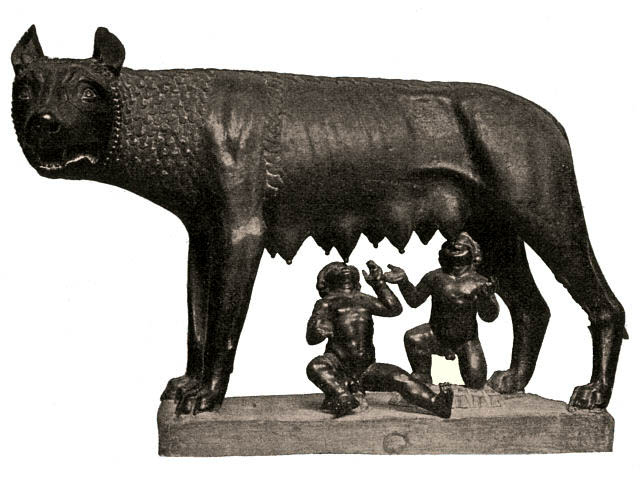 |
|
JULY 31 |
AUG 1 |
|
2 (214) |
3 |
4
(*136) |
5 |
6 |
 |
 |
 |
 |
 |
 |
 |
|
Ga5-22 |
Ga5-23 |
Ga5-24 |
Ga5-25 (135) |
Ga5-26 |
Ga5-27 |
Ga5-28 |
|
δ Muscae (196.5),
VINDEMIATRIX (Grape Gatherer) =
ε Virginis
(196.8) |
13h (197.8)
ξ╣ Centauri (197.1), ξ▓ Centauri
(197.9) |
APAMI-ATSA (Child of Waters) = θ
Virginis,
ψ Hydrae (198.5),
DIADEM = α Com. Ber.
(198.9) |
AL DAFĪRAH (Tuft) = β Com. Ber.
(199.4) |
σ Virginis (200.4) |
γ Hydrae (201.0), ι Centauri
(201.4) |
Al Simāk-12 (Lofty) /
Chitra-14 (Bright One) /
Horn-1 (Crocodile) /
Sa-Sha-Shirū-19
(Virgin's Girdle)
/
ANA-ROTO-3
(Middle pillar)
MIZAR (Girdle) = ζ Ursae Majoris
(202.4),
SPICA = α Virginis, ALCOR = 80
Ursae Majoris
(202.7)
SADALMELIK (α Aquarii)
|
|
Oct 3 |
4
(277) |
5 |
6 |
7 (*200) |
8 |
9 (282) |
|
░Sept 30 |
░Oct 1 |
2 |
3 (275) |
4
(*196) |
5 |
6 |
|
'Sept 6 |
7 (250) |
8 |
9 |
10 |
11 |
12 (*175) |
|
"Aug 23 |
(236 = 4 * 59) |
25 |
Hora Iti 26 |
27 |
28 |
Hora Iti 29 |
|
NAKSHATRA DATES: |
NAKSHATRA DATES: |
|
JAN 30 |
31 (396) |
FEBR 1 |
2 |
3 |
4
(400) |
5 (36) |
|
PAPA O PEA |
|
no star listed (14) |
1h (15.2)
β
Phoenicis (15.1), υ Phoenicis, ι
Tucanae (15.6), η Ceti, ζ
Phoenicis (15.7) |
Al Batn Al Hūt-26 (Belly of the
Fish) /
Revati-28 (Prosperous) / 1-iku
(0)
MIRACH = β Andromedae, KEUN MAN
MUN (Camp's South Gate) = φ
Andromedae
(16.0),
ANUNITUM = τ Piscium
(16.5),
REVATI (Abundant) = ζ Piscium
(16.9)
REGULUS (α Leonis)
|
ν
Phoenicis (17.4), κ Tucanae
(17.6) |
no star listed (18) |
ADHIL (Garment's Train) = ξ
Andromedae
(19.3), θ Ceti (19.7) |
KSORA (Knee) = δ Cassiopeiae
(20.1), ω Andromedae (20.6), γ
Phoenicis (20.8) |
|
April 4 |
5 (460) |
6 |
7 |
8 |
9 (*384) |
10 (100) |
|
░March 31 |
░April 1 (91) |
2 |
3 |
4 |
5 |
6 (*16) |
|
'March 8 |
9 |
10 (*354) |
11 |
12 |
13 (72) |
3-14 |
|
"Febr 22 (53) |
TERMINALIA |
24 |
25 |
26 |
27 |
28 |
The Bay of Turtles (Hanga Hoonu) was earlier,
however, a place where all the Explorers had
enjoyed a hot meal on 3 kinds
of fishes - in contrast to the bad time when
the Turtle came up on land:
... Again they went on and reached Hanga
Hoonu. They saw it, looked around, and
gave the name 'Hanga Hoonu A Hau Maka'.
On the same day, when they had reached the
Bay of Turtles, they made camp and rested.
They all saw the fish that were there, that
were present in large numbers - Ah! Then
they all went into the water, moved toward
the shore, and threw the fish (with their
hands) onto the dry land. There were great
numbers (? ka-mea-ro) of fish. There
were tutuhi, paparava, and
tahe mata pukupuku. Those were the three
kinds of fish.
After they had thrown the fish on the beach,
Ira said, 'Make a fire and prepare
the fish!' When he saw that there was no
fire, Ira said, 'One of you go and
bring the fire from Hanga Te Pau!'
One of the young men went to the fire, took
the fire and provisions (from the boat),
turned around, and went back to Hanga
Hoonu. When he arrived there, he sat
down. They prepared the fish in the fire on
the flat rocks, cooked them, and ate until
they were completely satisfied. Then they
gave the name 'The rock, where (the fish)
were prepared in the fire with makoi
(fruit of Thespesia populnea?)
belongs to Ira' (Te Papa Tunu
Makoi A Ira). They remained in
Hanga Hoonu for five days ...
Their stay at Hanga Hoonu
(Hanga-ohonu in the map below)
evidently had occurred already before they reached
Rangi Meamea and the beautiful beach of
Oromanga - which should be to the
west of Hanga-ohonu because
Oromanga was at Anakena and the
Sun went from east to west:
... The dream soul came to Rangi Meamea
and looked around searchingly. The dream
soul spoke: 'Here at last is level land
where the king can live.' She named the
place Rangi Meamea A Hau Maka O Hiva.
The mountain she named Peke Tau O Hiti A
Hau Maka O Hiva. The dream soul moved
along a curve from Peke Tau O Hiti to
the mountain Hau Epa
[Maunga Auhepa],
which she named
Maunga Hau Epa A Hau Maka O Hiva.
The dream soul went to the other side of the
mountain Hau Epa. As soon as the
dream soul looked around, she saw the sand
(beach), which was very white and light.

She
remained there and explored everything.
After she had looked around carefully, the
dream soul of Hau Maka said, 'Ah!
This is the place that will serve as a
residence for the king. She named the place
Oromanga A Hau Maka O Hiva and also
named the neighboring bay Hanga Moria One
A Hau Maka O Hiva ...
|
i
te rua te kauatu matoru raa o te
ana
kena i oho mai ai ki rangi
meamea.he
tuu he ui he tikea he nape i te
ingoa.ko ra
ngi meamea.a hau maka.he nape
tokoa
i
te ingoa o te maunga ko peke tau
o hiti
a
hau maka.he vari mai ki te rua
painga
o
maunga hau epa.he tikea.he nape
i te
ingoa ko maunga hau epa. a Hau
maka.
he vari hokoou mai ki te rua
painga o
maunga hau epa. |
On the twenty-third day of the
month of July ('Anakena'),
they reached Rangi Meamea.
When they arrived there, they
looked around and gave the name
'Rangi Meamea A Hau Maka'.
They also named the mountain 'Peke
Tau O Hiti A Hau Maka'.
They went around to the other
side of the mountain
Hau Epa, looked
around, and gave the name 'Hau
Epa A Hau Maka'. |
p. 26 |
|
Lower third of the page cut off. |
|
i ka onga mai nei ko te one
ku tea ku ri
torito ana. he ki he ro
korua e.i ana
nei te maara.mo noho mo te
ariki he no
ho.he ata rarama i te
maara.he angiangi
rivariva e Ira.he nape i te
ingoa o te hanga
ko hanga moria one a Hau
maka.he nape
i te ingoa o te maara ko
oromoanga.he noho
he hakaora.anake.i ka ui atu
ena ko te
honu ku tomo ana ki uta ki
runga ki te
one.he tikea he ki he ro
korua e.ko te
honu ku hoa ana ki uta he ki
amua ta
tou ki oho ki huri mai ki
uta he oho a
nake he tuu he ketu mai i te
honu.he oho
te kope rae.ko Ira.he ketu
mai i te ho
nu.kai ngaei mai.he ki atu a
raparenga
ina ai o (koe) kei ka maeha
koe ki oho a
tu au.he oho a
Raparenga.(h)e ketu
mai i te honu kai ngaei te
honu i a Raparenga. |
When he (i.e., Ira)
saw that the beach was white
and clean, he said, 'Hey,
you! Here is the place where
the king can live!'
The stayed there and
surveyed the plain with
great care. Ira knew
with certainty that it was
very good.
He named the bay 'Hanga
Moria One' and the plain
'Oromanga'.
They all sat down and
rested, when suddenly they
saw that a turtle had
reached the shore and had
crawled up on the beach.
He looked at it and said,
'Hey, you! The turtle has
come on land!' He said,
'Let's go! Let's go back to
the shore.' They all went to
pick up the turtle.
Ira
was the first one to try to
lift the turtle - but she
didn't move.
Then Raparenga said,
'You do not have the
necessary ability. Get out
of my way so that I can have
a try!'
Raparenga
stepped up and tried to lift
the turtle - but
Raparenga could not move
her. |
p. 27 |
In other words, the Explorers' encounter with the Turtle coming
ashore was after they had reached Rangi
Meamea in "July 23, whereas their hot
meal on 3 kinds of fishes in Hanga Hoonu
was before Anakena 23. Possibly the
inspiration to include these 3 kinds of
fishes in the story came from the pair in
Pisces and the single fish Piscis Austrinus
(Piscis Notius according to Hevelius), which
were at the Full Moon late in JUNE. And
perhaps they fetched fire as if from the funeral
pyre in ST JOHN'S DAY.

... Midway comes St. John's Day, June 24th,
the day on which the oak-king was
sacrificially burned alive. The Celtic year
was divided into two halves with the second
half beginning in July, apparently after a
seven-day wake, or funeral feast, in the
oak-king's honour ...
|
ST JOHN'S DAY |
JUNE 25 |
26 (177) |
27 |
 |
 |
 |
 |
|
(96)
Ga4-12 |
Ga4-13 (96) |
Ga4-14 |
Ga4-15 |
|
p Carinae
(159.3) |
φ Hydrae
(160.3) |
no star listed (161) |
VATHORZ POSTERIOR =
θ Carinae
(162.1),
PEREGRINI = μ Velorum,
η Carinae (162.6) |
|
August 27 |
28 (240) |
29 (*161) |
30 |
|
░August 23 |
24 (236) |
25 (*157) |
26 |
|
'July 31 |
'August 1 |
2 (214) |
3 (*500) |
|
"July 17 |
Anakena 18 |
19 (200) |
20 (*121) |
|
... They made camp and rested at
the Bay of Flies for a week (etahi
pohitu). On the
eighteenth day of the month of
July (Anakena) they went
on from Hanga Takaure.
They climbed uphill, went on,
and reached Poike. When
they arrived, they looked around
and named (the place) 'Poike
A Hau Maka'. They climbed up
farther to Pua Katiki.
When they arrived there, they
looked around and named (the
place) 'Pua Katiki A Hau Maka'.
They came down from the height,
from the mountain, from Pua
Katiki, and reached
Maunga Teatea. They looked
around and gave the name 'Maunga
Teatea A Hau Maka'. They all
descended, they all came down
from Pua Katiki. They
reached Mahatua, saw it,
looked around, and gave the name
'Mahatua A Hau Maka'.
Then they went on and came to
Taharoa. They saw it, looked
around, and gave the name 'Taharoa
A Hau Maka'.
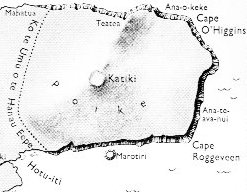
Again they went on and reached Hanga
Hoonu. They saw it, looked around, and
gave the name 'Hanga Hoonu A Hau Maka'.
On the same day, when they had
reached the Bay of Turtles, they
made camp and rested. They all
saw the fish that were there,
that were present in large
numbers - Ah! Then they all went
into the water, moved toward the
shore, and threw the fish (with
their hands) onto the dry land
... |
|
NAKSHATRA DATES: |
|
CHRISTMAS EVE |
DECEMBER 25 |
26 (360) |
27 |
|
HANGA HOONU |
|
η Aquarii
(342.1), σ Gruis (340.4),
SITULA = κ Aquarii
(342.7) |
ε
Piscis Austrini (343.5), ο
Pegasi, β Gruis (343.8) |
ρ
Gruis (344.0),
MATAR = η Pegasi
(344.2), η Gruis (344.6), β Oct.
(344.7) |
λ
Pegasi (345.0), ξ Pegasi
(345.1), ε Gruis (345.3), τ
Aquarii (345.7), ξ Oct. (345.8),
μ Pegasi (345.9) |
|
February 26 |
27 (58) |
28 (424) |
March 1 (*345) |
|
░February 22 |
TERMINALIA |
24 (55) |
25 |
|
'January 30 (*315) |
31 |
'February 1 (32) |
2 |
|
"January 16 (*301) |
17 |
18
(383) |
19 |
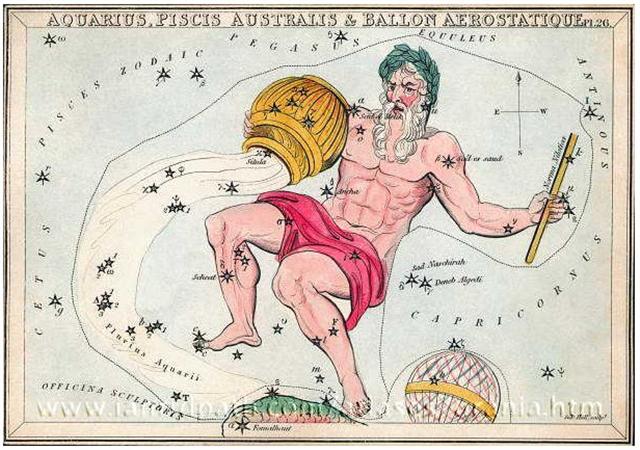 |
|
JUNE 28 |
29 (180) |
SIRIUS |
JULY 1 (*102) |
 |
 |
 |
 |
|
(100) Ga4-16 |
Ga4-17 (100) |
Ga4-18 |
Ga4-19 |
|
ν Hydrae (163.1) |
no star listed (164)
ALTAIR (α Aquilae)
|
Wings-27 (Snake)
η Oct. (165.4),
ALKES (Shallow Basin) = α
Crateris
(165.6) |
ANA-TIPU-4 (Upper-side-pillar -
where the guards stood)
MERAK = β Ursae Majoris
(166.2),
DUBHE (Bear) = α Ursae Majoris
(166.7) |
|
Aug 31 |
Sept 1 |
2 (*165) |
3 (246) |
|
░Aug 27 |
28 |
29 (*161) |
30 (242) |
|
'Aug 4 (216) |
5 (*137) |
6 |
7 |
|
"July 21 |
22 / 7 |
Anakena 23 (204) |
24 (*125) |
|
... Everywhere the dream soul
looked around for a residence
for the king. The dream soul
went to Maunga Teatea and
gave him the name Maunga
Teatea A Hau Maka O Hiva.
The dream soul of Hau Maka
looked around. From Maunga
Teatea she looked to
Rangi Meamea (i.e., Ovahe).
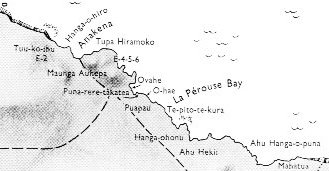
The dream soul spoke the
following: There it is - ho! -
the place - ho! - for the king -
ho! - to live (there in the
future), for this is (indeed)
Rangi Meamea ...
... The Explorers arrived at
Rangi Meamea in "July 23 (Anakena
23) and there they stayed on
the beautiful beach of
Oromanga for 27 days ...
... When Hotu's canoe had
reached Taharoa, the
vaginal fluid (of Hotu's
pregnant wife) appeared. They
sailed towards Hanga
Hoonu [Bay of Turtles],
where the mucus (kovare
seems to refer to the amniotic
sac in this case) appeared. They
sailed on and came to Rangi
Meamea, where the
amniotic fluid ran out and the
conctractions began. They
anchored the
canoe in the front part of the
bay, in Hanga Rau.
The canoe of Ava Rei Pua
also arrived and anchoraged.
After Hotu's canoe had
anchoraged, the child of
Vakai and Hotu
appeared. It was Tuu Maheke,
son of Hotu, a boy. After
the canoe of Ava Rei Pua
had also arrived and anchoraged,
the child of Ava Rei Pua
was born.
It
was a girl named Ava Rei Pua
Poki ...
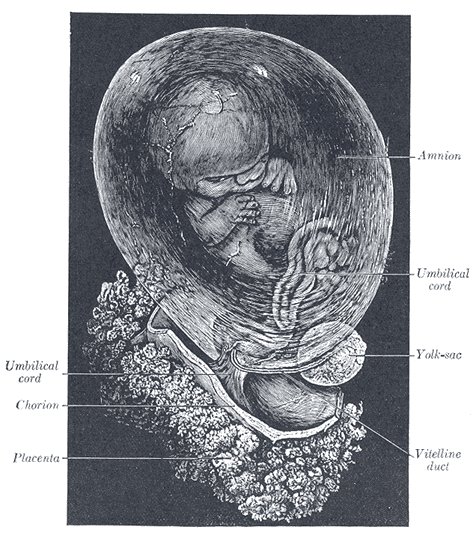 |
|
NAKSHATRA DATES: |
|
DECEMBER 28 |
29 |
30 (364) |
31 (*285) |
|
HANGA HOONU |
|
ι
Cephei (346.0), λ Aquarii, γ
Piscis Austrini, σ Pegasi
(346.5) |
SCHEAT AQUARII = δ Aquarii
(347.0), ρ Pegasi (347.2), δ
Piscis Austrini (347.4),
FOMALHAUT (Mouth of the Fish) =
α Piscis Austrini,
τ Gruis (347.8) |
FUM AL SAMAKAH (Mouth of the
Fish) = β Piscium
(348.3), ζ Gruis (348.5), ο
Andromedae (348.9) |
Al Fargh al Mukdim-24 (Fore
Spout) /
Purva Bhādrapadā-26 (First of
the Blessed Feet) /
House-13 (Pig)
SCHEAT PEGASI = β Pegasi,
π Piscis Austrini (349.3), κ
Gruis (349.4),
MARKAB PEGASI = α Pegasi
(349.5) |
|
March 2 |
3-3 |
4
(*348) |
5 (64) |
|
░Febr 26 |
2-27 |
28 (*344) |
░March 1 (60) |
|
'Febr 3 |
4
(400 = 365 + 35) |
5 (36) |
6 (*322) |
|
"Jan 20 |
21 (2 * 193) |
22 |
23 (*308) |
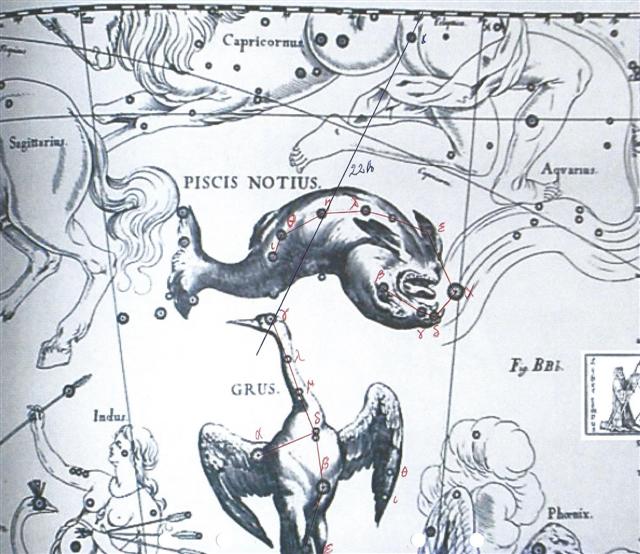 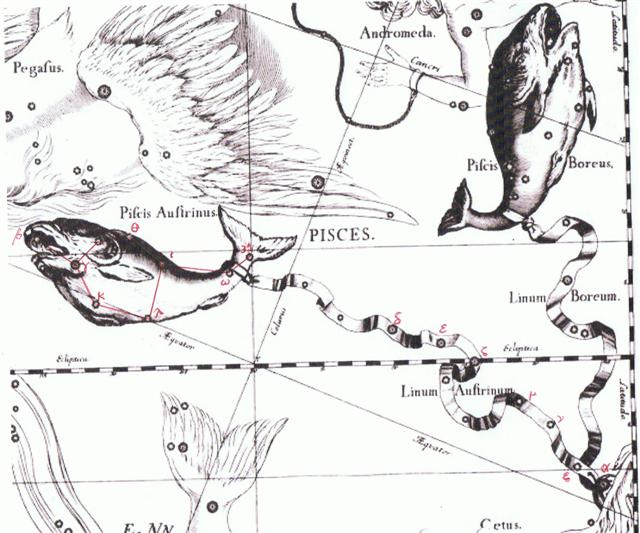 |
On Easter Island the name
for December was Ko Korˇ:
|
... The ancient names of the
month were: Tua haro,
Tehetu'up˙, Tarahao, Vaitu nui,
Vaitu poru, He Maro, He Anakena,
Hora iti, Hora nui, Tagaroa uri,
Ko Ruti, Ko Korˇ ... |
|
Koro.
1. Father (seems
to be an older word than
matu'a tamÔroa). 2. Feast,
festival; this is the generic
term for feasts featuring songs
and banquetting; koro
hakaopo, feast where men and
women danced. 3. When (also:
ana koro); ana koro oho
au ki Anakena, when I go to
Anakena; in case, koro
haga e ţa, in case he
wants it. Vanaga.
If. Korokoro,
To clack the tongue (kurukuru).
Churchill.
Ma.: aokoro, pukoro,
a halo around the moon. Vi.:
virikoro, a circle around
the moon. There is a complete
accord from EfatÚ through Viti
to Polynesia in the main use of
this stem and in the particular
use which is set to itself
apart. In EfatÚ koro
answers equally well for fence
and for halo. In the marked
advance which characterizes
social life in Viti and among
the Maori the need has been felt
of qualifying koro in
some distinctive manner when its
reference is celestial. In Viti
virimbai has the meaning
of putting up a fence (mbai
fence); viri does not
appear independently in this
use, but it is undoubtedly
homogenetic with Samoan vili,
which has a basic meaning of
going around; virikoro
then signifies the
ring-fence-that-goes-around, sc.
the moon. In the Maori,
aokoro is the cloud-fence.
Churchill 2. |
The circle of the year
was completed in December according to
the view adopted from civilized man
north of the equator:
...
Whare-patari, who is credited
with introducing the year of twelve
months into New Zealand, had a staff
with twelve notches on it. He went on a
visit to some people called Rua-roa
(Long pit)
[Ta.:
ruaroa, tropic of Capricorn] who
were famous round about for their
extensive knowledge. They inquired of
Whare how many months the year had
according to his reckoning. He showed
them the staff with its twelve notches,
one for each month. They replied: 'We
are in error since we have but ten
months. Are we wrong in lifting our crop
of kumara (sweet potato) in the
eighth month?' Whare-patari
answered: 'You are wrong. Leave them
until the tenth month. Know you not that
there are two odd feathers in a bird's
tail? Likewise there are two odd months
in the year.' The grateful tribe of
Rua-roa adopted Whare's
advice and found the sweet potato crop
greatly improved as the result ... The
Maori further accounted for the twelve
months by calling attention to the fact
that there are twelve feathers in the
tail of the huia bird and twelve
in the choker or bunch of white feathers
which adorns the neck of the parson bird
...
|
Hagahuru.
Ten (agahuru,
hagauru). P Mq.:
onohu˙, okohu˙, id.
Ta.: ahuru. id.
Churchill.
The Maori recognized two main
divisions of the year: winter or
takurua, a name for
Sirius which then shone as
morning star, and summer,
raumati or o-rongo-nui,
'of the great Rongo', god
of agriculture. They
occasionally recognized spring
as the digging season koanga,
from ko, the digging
stick or spade. The autumn or
harvest season was usually
spoken of as ngahuru,
'tenth' (month), although it was
considered to include also the
last two months of the year.
Mahuru was the
personification of spring.
Makemson. |
When the Sun was at
Sirius, in JUNE 30, then the Full Moon
was in late DECEMBER. Therefore there
should be a feast (koro) on 3
kinds of fishes (Piscis Notius,
Austrinus, and Boreus) which were
located there.
Why was this place named
Hanga Hoonu? Possibly because the
Chinese had a Turtle here:

|





















